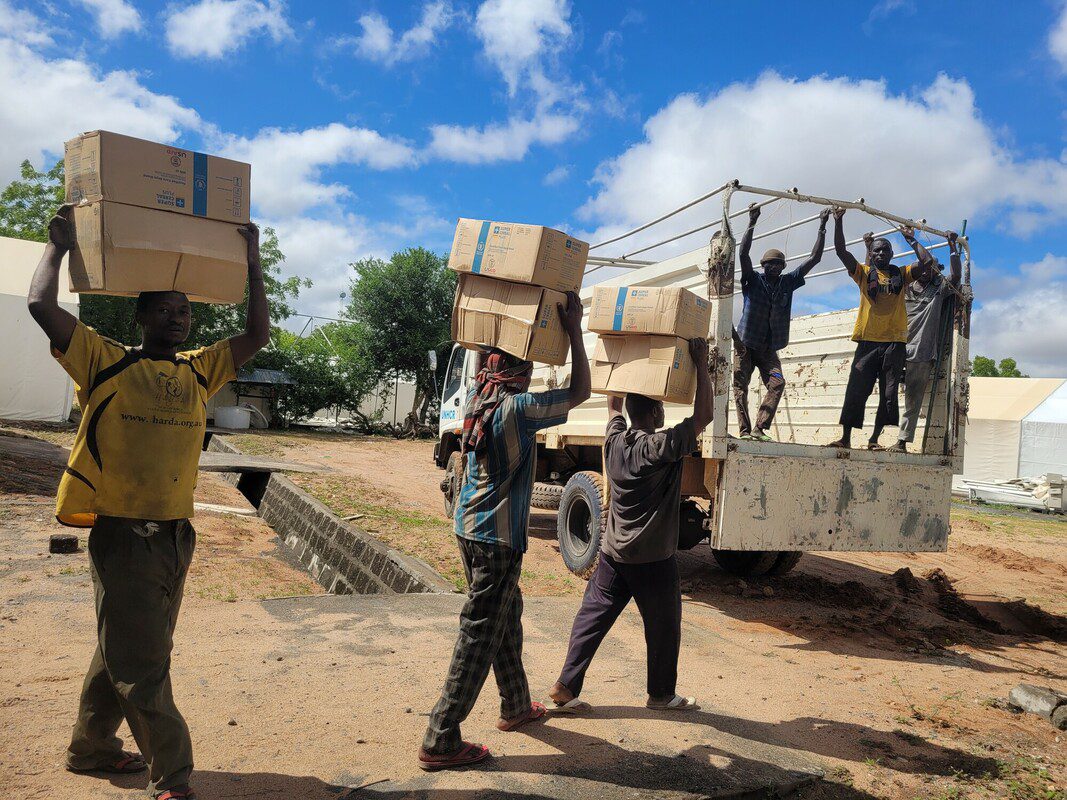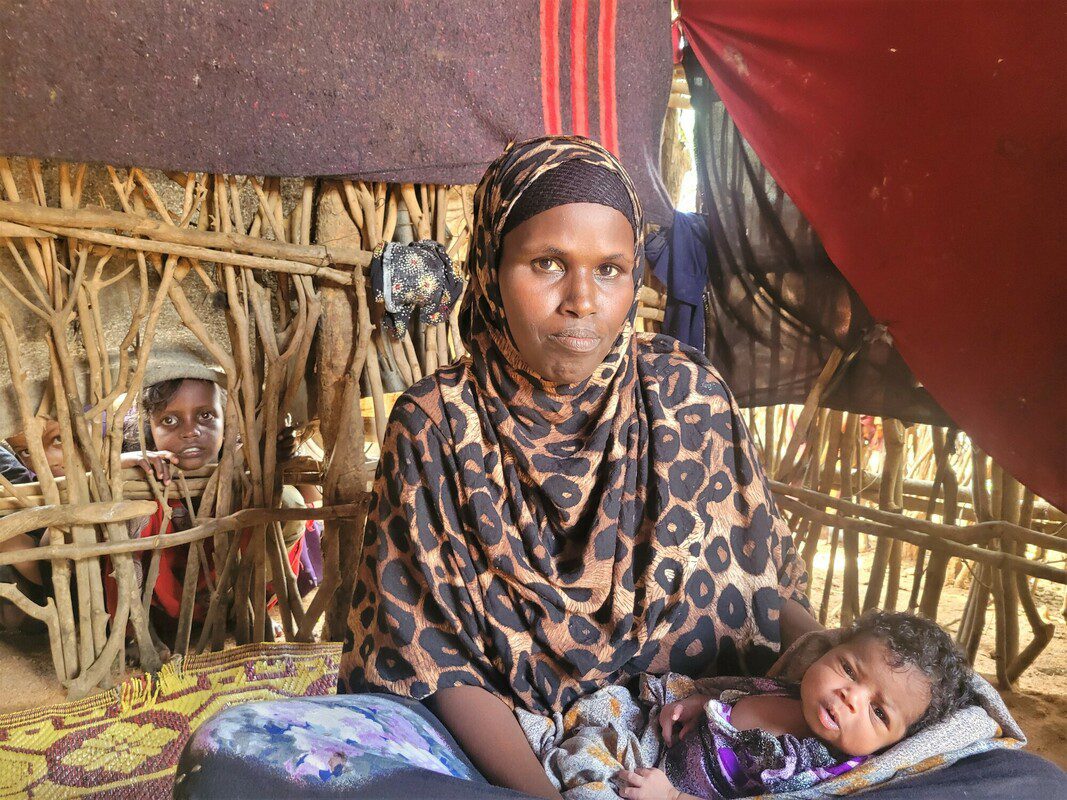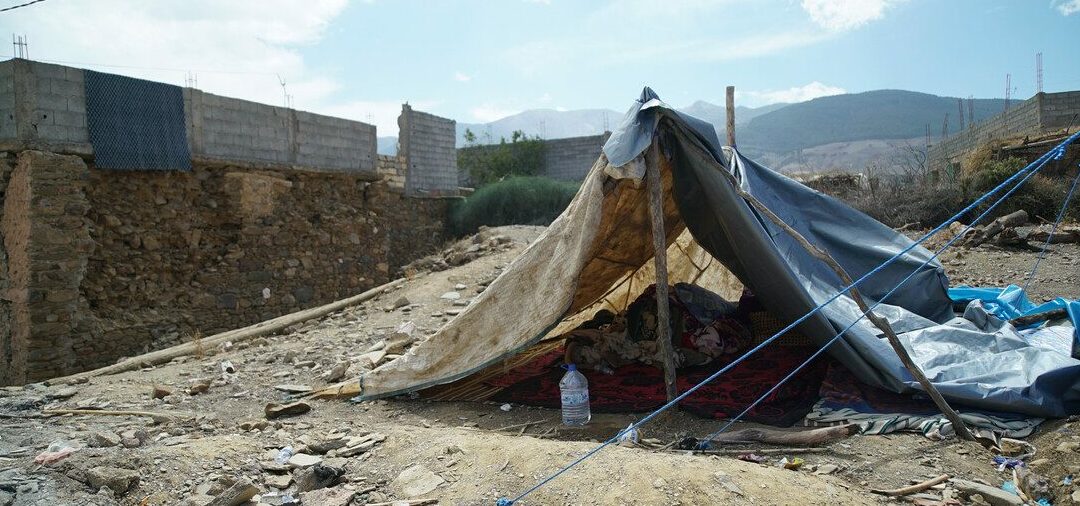By Sarah Easter, Emergency Communications Officer CARE Germany and CARE Austria
I am walking through a narrow passage with high metal grids on the left and right. Occasionally there is a hole in the grid, just big enough for my hand to fit through. This is where refugees in Dadaab refugee camp in Kenya have their fingerprints read as they line up to receive their monthly food ration. The left passage is for the women while the right is for the men. Now the passages are empty. The next distribution is at the beginning of next month by the World Food Programme and CARE. While I am walking through one of the three distribution centres at Dadaab, I can only imagine how many people walk here every day with their sacks and jerrycans on distribution days. In fact, it’s between 10,000 and 15,000 refugees every day.
I continue walking to the storage unit, where the food is being packed and prepared for next month’s distribution. I talk to the aid workers who are carrying big boxes of milk powder on their heads from a big white storage tent to a waiting truck. They tell me about the challenges they face. They point to a sack of wheat in the next tent. Written on the sacks in big blue letters is the point of origin: Ukraine. Since the war, the deliveries of wheat have been delayed. Delivery ships were stuck or didn’t arrive. The current floods in the region have also delayed delivery trucks and destroyed one of the storage tents.
Then there are the new arrivals. So many people have recently arrived in Dadaab that the limited food resources are being stretched even further. Every person now only receives 80 per cent of the recommended food ration. Last year there was a time when it was down to just 52 per cent. For a moment, I stare at the number I have just written down in my notebook and cannot believe it. People who are starving. Children who are malnourished. Families who have been walking for weeks in harsh dry landscapes between Kenya and Somalia, desperately hoping to survive somehow. How are they to survive with half of the rations? I ask them what the reason for this is. Is there no other way to get enough food for everyone? They shake their heads and rub their thumbs over the index and middle finger: money. There is not enough financial support for Dadaab or the organizations working here. There has been less and less international financial support over the years. Media attention is waning. Donations are drying up. That is why families in Dadaab sleep hungry on mats on the floor every night.


Sarah Easter/CARE
I meet Saruro, who came to the refugee camp when she was three years old. That was 31 years ago. She tells me that she hasn’t received the scheduled soap delivery from another organization because they don’t have the money and had to stop distributing soap. I witness women pushing each other to get to the water tap that gives out a limited amount of drinking water. A mother sitting next to me is giving her little boy a bowl of mud water from the puddles. Children sleep outside under the open sky because there is not enough space for them inside the makeshift shelter their parents built for the family. The camp is filled to the brim and is home to three times the population they were designed for. Another 135,000 new arrivals live outside of the camp because there is no more space for them. CARE continues to distribute food to all refugees together with the World Food Programme, but if there is no new financial support to meet the increased needs, food will run out much sooner. I take out my phone and look up the number of how much of the financial needs have been covered for this year. When I see the number, I have to take a deep breath and close my eyes. Only 2.2 per cent is funded so far. Not even $1 million USD has been funded. Another $42 million USD are needed so families can have enough food, water, shelter, health support and toilets. This only covers basic needs. Long-term projects that build resilience or provide future security and growth like income, training, and education are not even listed.
This has been the situation in the camp for a very long time. The camp is nearly as old as I am. While I take my notes and walk through the centre, I think about Saruro who came here every month for the last thirty years because she has no other option. She cannot go back to Somalia, because of the ongoing conflict and lack of food, water and the ability to earn an income due to the drought, and she cannot leave the camp. While I was a child in school, Saruro stood in line every month. While I went to university, she stood here, hoping to receive enough to feed herself and her family. While I started my first job, she opened her sack and a humanitarian aid worker scooped wheat inside. Last year she received 52 per cent of her food ration, going to sleep hungry. And in two weeks she will be standing here again, waiting for her 80 per cent of her food ration, hoping that next month and the month after, she will still receive enough food to survive. I try to imagine this life and endless cycle. Saruro then tells me that her biggest wish is to just see the “modern world” once in her life. She doesn’t even want to live there. She has no hope for that, she tells me. This breaks my heart.
My first reaction is anger. Why does no one care about what is happening here? While Saruro just wants to see the “modern world” once, most in the “modern world” don’t even know that she is here. That she has been standing in line for 31 years and that there won’t be enough food for her if new resources aren’t allocated. My second reaction is a fierce determination that we need to do better. We need to be informed. We need to listen to the people that need our attention. To not look away, but to help, so that people like Saruro don’t have to worry about where their next meal comes from, but instead work on long-term progress for themselves, their families and neighbours.


Sarah Easter/CARE
How CARE helps:
CARE supports the new arrivals with the supply and installation of micro water storage facilities which can hold up to 5,000 liters of drinking water, distributes plastic jerricans, constructs communal latrines and supplies soap bars to all new arrival households residing in the outskirts. Additionally, women and girls are provided with menstrual hygiene dignity kits.
Help save lives during emergencies and fight poverty over the long term.
Related news & stories


GAZA: Military offensive on Rafah would be a “cruel and heart-breaking blow”
APRIL 26, 2024 – As...


Canadian Aid Sector Welcomes Budget Boost for Humanitarian Needs
OTTAWA, APRIL 16 2024 –...


Morocco: More than six months after the earthquake, the road to recovery remains long
On September 8, 2023,...

